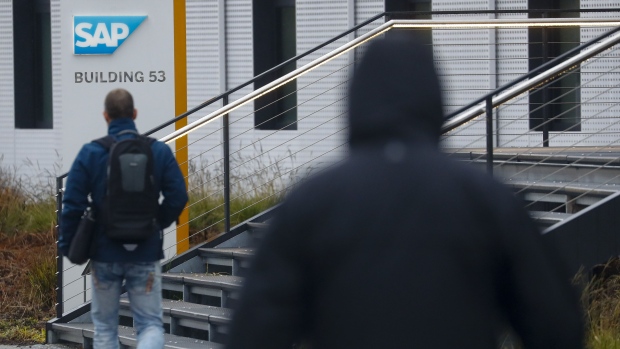Mar 11, 2022
SAP Seeks to Raise Fees on Largest Software Partners
, Bloomberg News

(Bloomberg) -- SAP SE is renegotiating the royalty fees it collects from its largest software sales partners, seeking to squeeze out more revenue from these relationships in exchange for better access to the German software giant’s technology and support.
The discussions are part of a revamp of SAP’s partnership program that also is poised to make it easier for many other software vendors to work with SAP’s expansive line of tools. The effort is an attempt by SAP to leverage strong sales momentum for its signature product that runs back-office functions like accounting and procurement to get more money from partners who will benefit from that boost.
SAP’s move to change its partnership structure, which hasn’t been previously reported, highlights an extremely opaque part of the software business. Partnerships are a common arrangement in which software makers pay to access each other’s technology, sell products together or develop tools jointly, among other benefits. Few providers publicly disclose the terms of the contracts under which partners pay a portion of product revenue to, in the case of SAP, integrate their systems into SAP’s tools.
“This is not an across-the-board increase in SAP’s partner fees or revenue percentages,” Tom Roberts, an SAP senior vice president, said in an interview. Some partners “have been invited in to a higher-level tier and we’re in private negotiations.”
In the consumer world, the software partnerships are akin to Alphabet Inc. paying Apple Inc. to be the default web browser on iPhones. But in the software world, because the contracts are rarely disclosed, customers who use the products don’t know whether the costs are being passed along to them. In other words, a company that uses the software could unknowingly be paying two different vendors for what seems to them a single integrated product.
The deals can range in magnitude. Amazon.com Inc. and Salesforce.com Inc., for example, inked an agreement in 2020 to sell a suite of tools built by both companies. But a partnership also may be as straight-forward as DocuSign Inc. allowing Slack to build a connection into DocuSign’s e-signature product that lets users sign documents directly in Slack’s instant message platform.
The negotiations come at a critical time for Walldorf, Germany-based SAP. The company needs to keep key partners as it transitions customers from on-premises tools to new cloud-based software, an effort that appears to be gaining momentum after faltering early in the pandemic. SAP said cloud revenue increased 28% to $2.9 billion in the fourth quarter and projected a similar percentage jump for 2022. The partnership changes also are important for other software vendors to be able to plug into SAP’s products, which support everything from supply chain oversight to expense management and hold valuable data about its corporate customers.
“We want our partners to move with us and we want to try do that in as lock-step of fashion as possible,” Roberts said.
Most executives publicly acknowledge the increasing need for “coopertition” in the industry. But behind-the-scenes, partner agreement negotiations are often bitter as companies fight to exert their industry dominance for more favorable terms.
In the past, SAP used a tiered structure to determine what percentage of product revenue a company must share as a royalty in order to join the partner program. Some vendors were paying as much as 35%, while others were paying as low as 15%. SAP also charged a fee, generally 15%, to list a partner on its online marketplace, a directory where prospective customers could browse a list of “SAP approved” products. That could make it easier for a customer to figure out which vendors sell tools that would work best with their existing SAP products.
Now, SAP is eliminating the fee for a vast majority of partners to gain access to its online marketplace, Roberts said. Many will also pay a lower fee to connect into SAP’s systems, down to 15% of product revenue from 20%. The changes are expected to be announced imminently.
Other partners, however, may have higher fees imposed on them. Unlike the lower-tier, which is open to join, SAP is hoping to deepen its partnership with a smaller group of invitation-only companies. There would be no set royalty fee for these software vendors. Instead, SAP is seeking to negotiate individual contracts with each. While the fees will ultimately be higher than what some partners were paying before, Roberts argued that the agreements will come with added benefits, like additional sales support.
“We think that’s fair. We’re trying to run partnerships that we’re going to invest in and make market impact together. Quite naturally, the skin in the game is going to be higher,” he said.
Roberts declined to say which companies were included in the higher-tier, except to say it is “dozens” of vendors versus the “hundreds or thousands” of providers that will now pay lower fees.
Geoff Scott, chief executive officer of Americas’ SAP Users’ Group, an independent group of SAP customers, said it would be a “welcomed change” for the software giant to be more transparent about its partner relationships.
“The partner ecosystem is more complex than its ever been,” Scott said.
SAP is also revising its process for cloud infrastructure partners, a small group of vendors that includes giants like Microsoft Corp. and Alphabet’s Google Cloud. To join the program, providers must now pay $3 million, an increase from as little as $500,000. That’s significantly higher than the few thousands of dollars that application vendors have to spend to get their products certified.
“It’s really the biggest partners that we have, that are out there in the market. So we have to treat them equally for competitive reasons,” said Stefan Goebel, head of strategic engineering partnerships at SAP.
©2022 Bloomberg L.P.





